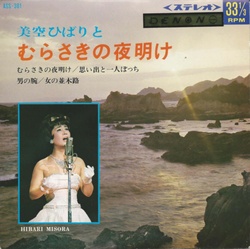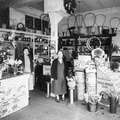“The day the music died,” from the song “American Pie” by Don McLean, referred to February 3, 1959, the day Buddy Holly, Richie Valens, and the Big Bopper perished in the ill-fated plane crash in Clear Lake, Iowa. Those who were teenagers back then remembered ever so clearly when they heard the tragic news. You know exactly where you were and what you were doing. Music does that. Remember that song on the phonograph for the home waltz at the school dance? You don’t forget who you were dancing with, and how you had such a mad crush on that person! Music conjures up many personal memories.
I’m trying to imagine how music played such a key role in the lives of the Japanese immigrants and the children who were born listening to Japanese and American/Canadian songs on Powell Street or in Steveston. Older Nisei children who grew up in Japantown remember going to Strathcona Elementary School and immediately after, attending the Japanese Language School. There was a time to participate in shibai or drama classes. Mitsi Sasaki-Fugeta in her interview told me that there was a shibai contest held each year in the early 1900s. The Shiga-ken actors and singers would win first prize nearly every year because of their lively rendition of “Yasuki Bushi.” Yasuki Bushi is a form of pantomime with lively music in the background.
Hollywood actor Robert Ito (who was interned in Tashme) began his career as a tap dancer. Young girls learned the traditional Japanese dances in both communities. Therefore, music played a huge part in “letting themselves go” from the hum-drum life of adults working long hours at the mill or fishing, and children attending two schools.
With Powell Street becoming a bustling community with stores and restaurants, records were probably available from Japan. In the 1930s, the big hit song was “Shina no Yoru” (China Night) by Hamako Watanabe. She claimed that her grandfather was a quarter American. Hamako went to China during the Sino-Japanese War and that’s where this song originated. When Japan lost the war, she became a POW in China. This song has become a standard for many generations and my sisters still know the lyrics to this song.
“Naniwa Bushi” was very popular with the older Nisei crowd. Another name was “Rokyoku,” accompanied by a shamisen. It was nicknamed “Sob Story.” Names like Minami Haruo and Kasuga Hachiro were put into my ears by my parents. Minami was famous for the song, “Chanchiki Okesa.” Kasuga sang, “Otomi San.” I can still hear the scratchy sound of the old 78 rpm vinyl records blaring away. As children, we thought it was hilarious. We mimicked the singer by singing, “Chaka chaka san yo!” The record would spin so fast that when the song was over, the head of the needle would snap back and scratch the record! Our parents called the phonograph, chikuonki (chik-on-ki).
During the 1960s in Greenwood, Shigin Club became a rage for the older crowd, however, this musical genre was probably an ancient form of art that was in existence in Japantown in the ’20s and ’30s. It was revived when someone introduced shigin to Greenwood Nikkei. Many older people took to this chanting very passionately. They practiced and performed in the basement of Mook’s Café, owned by the Mukai family. Everyone who was a member took it VERY seriously. They had to hit the right note for the high and low sounds. Sometimes, a chanter had to hold a note for a long time. For younger listeners, it sounded like someone was constipated! My dad was probably the worst singer, but he practiced every evening trying to hit the right notes. My mom, who was blind, had a natural talent for this type of music. Her hearing was much sharper so she knew the timing better. In a small town, this exercise gave Issei and Nisei folks a sense of camaraderie because other communities would pay a visit and check out each other’s progress. It wasn’t “Poetry in Motion” for us, but it was so inspirational to see your parents take such an interest in this activity.
By the mid-1930s, the younger Nisei teens were being exposed to modern music and the big band sound became cool. The Issei parents frowned on teens attending social dances and holding hands. The Nisei kids would learn the jitterbug and the fox trot. Names like Tommy Dorsey, Glenn Miller, Benny Goodman, Guy Lombardo, and Xavier Cugat became part of their lives. Teen lingo such as the Stomp, Rag, Swing, and Boogie Woogie became the new language of that era. Re-reading Frank Moritsugu’s article regarding the music of his time, he mentioned some of these bands.
Enka is a relatively new term so this music may have morphed from Naniwa Bushi. When Nisei teens grew into young adulthood, they were able to appreciate both genres. Hibari Misora, Yukio Hashi, Masao Sen, Saburo Kitajima, and Tokiko Kato became familiar names. Hibari’s first hit song was “Kappa Boogie Woogie” in 1949. However, her most notable song was “Yawara, ” a judo song. Kato Tokiko’s popular hit song “Shiretoko Ryojyo” was written by actor Hisaya Morishige when he stayed at the beautiful quaint village in Hokkaido. Olympic Silver medallists from Canada, Tessa Virtue and Scott Moir, selected this song for one of their performances.
Nisei teens, hearing songs on the Hit Parade, were more in tune to the songs of Bing Crosby, Louis Armstrong, Ella Fitzgerald, Vera Lynn, Judy Garland, and Frank Sinatra. In the early ’50s, Patti Page, with “Doggy in the Window” and “Tennessee Waltz” were big hits. Another female star was Doris Day singing “Sentimental Journey” and “Que Sera, Sera.” Doris’ last name was Kappelhoff, but the older Issei called her Dorosu (drawers) Day. “That’s My Desire” and “Rose, Rose, I Love You” made Frankie Laine a star in 1946, but his later western songs, “Rawhide” and “High Noon,” made him a musical icon. Frankie’s real name was Francesco LoVecchio. Singers like the Ink Spots and the Mills Brothers would perform in Vancouver. Nat “King” Cole was another big star with songs like “Route 66,” “Mona Lisa,” and “Rambling Rose.”
In the 1950s, many Nisei families started to disperse and move elsewhere after leaving the camps. Places like Greenwood and New Denver, however, still had significant Nikkei populations. One thing that stands out in my mind is that the younger Nisei teens were quite creative in changing the lyrics of a hit song. Remember the song, “Chattanooga Choo Choo” by the Andrew Sisters? I heard one boy singing, “Well, pardon me, boys, is that the Hatanaka Choo Choo?” An Italian novelty song “Eh Cumpari” was sung by Julius LaRosa. The lyrics went something like this, “Eh Cumpari, Ci vo sonari, Chi si sona, u saxafona…tipiti, tipiti ta…” There was a boy in Greenwood with the first name Yasunari, the second boy’s name was Michi Toda, and Gus Ishida’s nickname was ‘Pochinaga.” This one clever boy started to sing this song, and he sang it this way, “Eh Cumpari, Yasunari, Michi Toda, Pochinaga.”
Some of the group bands loved the number four: Four Lads, Four Aces, Four Preps, and so forth. However, in the early ’60s, the Beatles became the most famous quartet. Four Lads was a Canadian group and their hit songs were “Standing on the Corner,” “Moments to Remember,” and “Istanbul.” Another common band names had “tones” in it, like Monotones, Cleftones, Planotones, and Harptones.
Out of the blue, this “new” music caught the attention of the teens around 1955. It was called Rock and Roll! Elvis was the biggest thing to appear since slice bread. Bill Haley and the Comets’ song, “Rock Around the Clock” was made famous by the movie, Blackboard Jungle with Glen Ford as the star. It took off from there. Nikkei teens started to learn the “new” high energy dance, the Jive. However, we now know it originated from Lindy Hop and Jitterbug. The African-American singers rose from the underground radio station to become mainstream musical icons. Little Richard, Chuck Berry, Fats Domino, Platters, and Frankie Lymon and the Teenagers brought a whole new dimension and freshness to this genre. Sock Hop every Friday noon hour was a huge hit with the high school students. Every month, there was a school dance in the evening. If you can jive, you were considered “Daddy Cool” or “Hep Cat.” The years 1959 to 1968 were a time when the dance crazes became a phenomenon. Could you dance to The Twist? Chubby Checker’s song “The Twist” became the #1 hit song in two different years. In 1959, it was a hit with the teens, but in 1961, sophisticated society crowd embraced this dance because it was so simple to learn. Then came the Monkey, Swim, Watusi, Bop, and so on. The dancers on American Bandstand with Dick Clark taught us the moves. Every day from Monday through Friday from 3 p.m. till 5 p.m., eager teens just had to watch this show to learn new dances. Every Saturday evening at 7 p.m. was the Dick Clark Show. Frankie Avalon, Paul Anka, Annette Funicello, Connie Francis, Sam Cooke, and Chubby Checker performed regularly.
As the Nisei kids grew older and their musical taste changed, some reverted to enka. With the advent of karaoke, more and more Nikkei started to sing enka and followed Japanese stars like Yuzo Kayama, Sayuri Yoshinaga, Kyu Sakamoto, Shinichi Mori, and Takashi Hosokawa. Going to Olympia Theatre to watch Japanese movies became very popular. I suppose it’s very difficult to take the “Nisei” out of a Nikkei youth? What was the result of all this? Nisei kids who grew up in that era were bilingual more or less, and they were able to weave in and out of both cultures with ease.
*This article was originally published in the Geppo The Bulletin: a journal of Japanese Canadian community, history + culture on February 2, 2016, it has been edited by the author for Discover Nikkei.
© 2016 Chuck Tasaka







